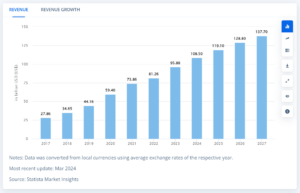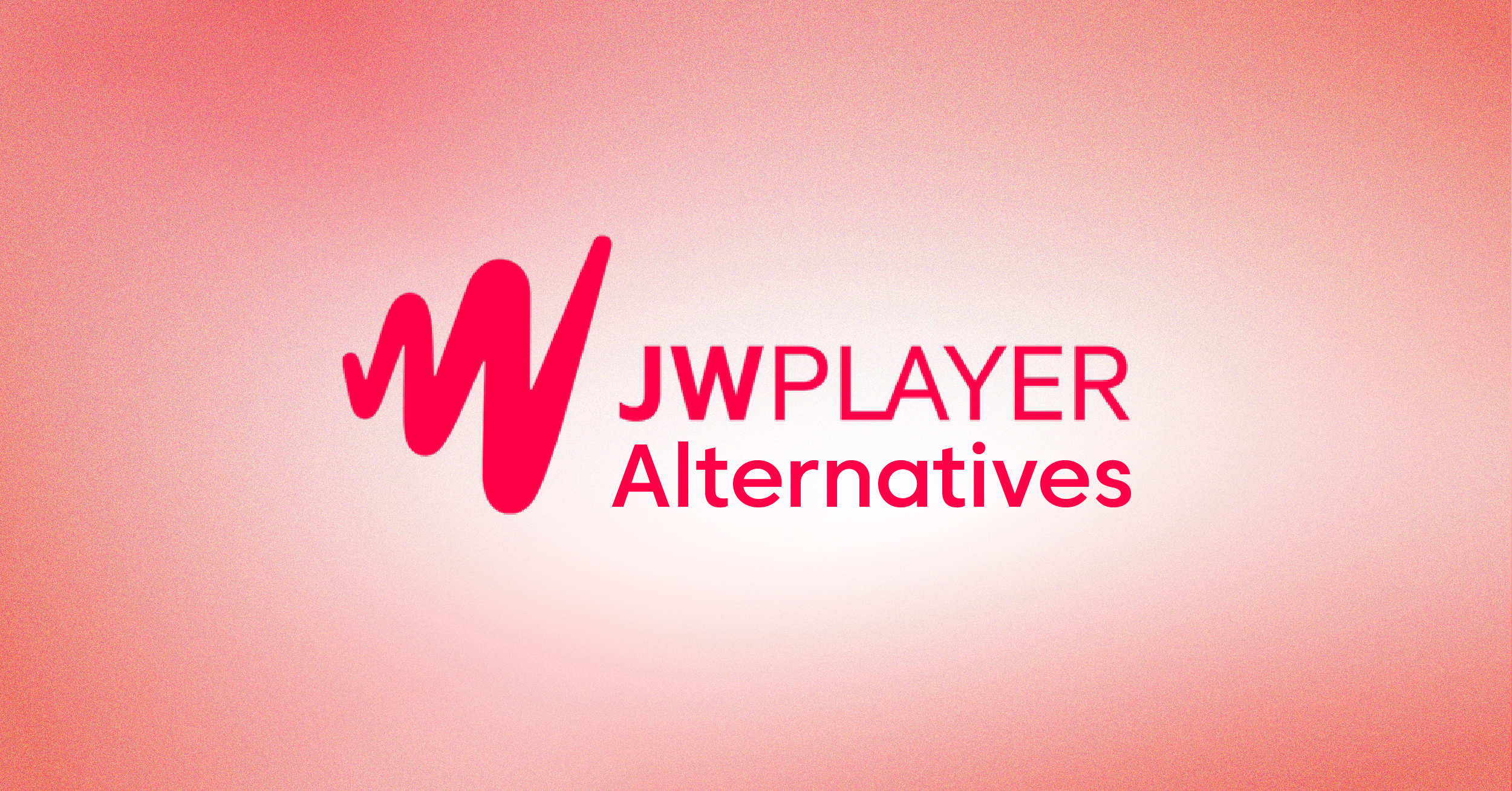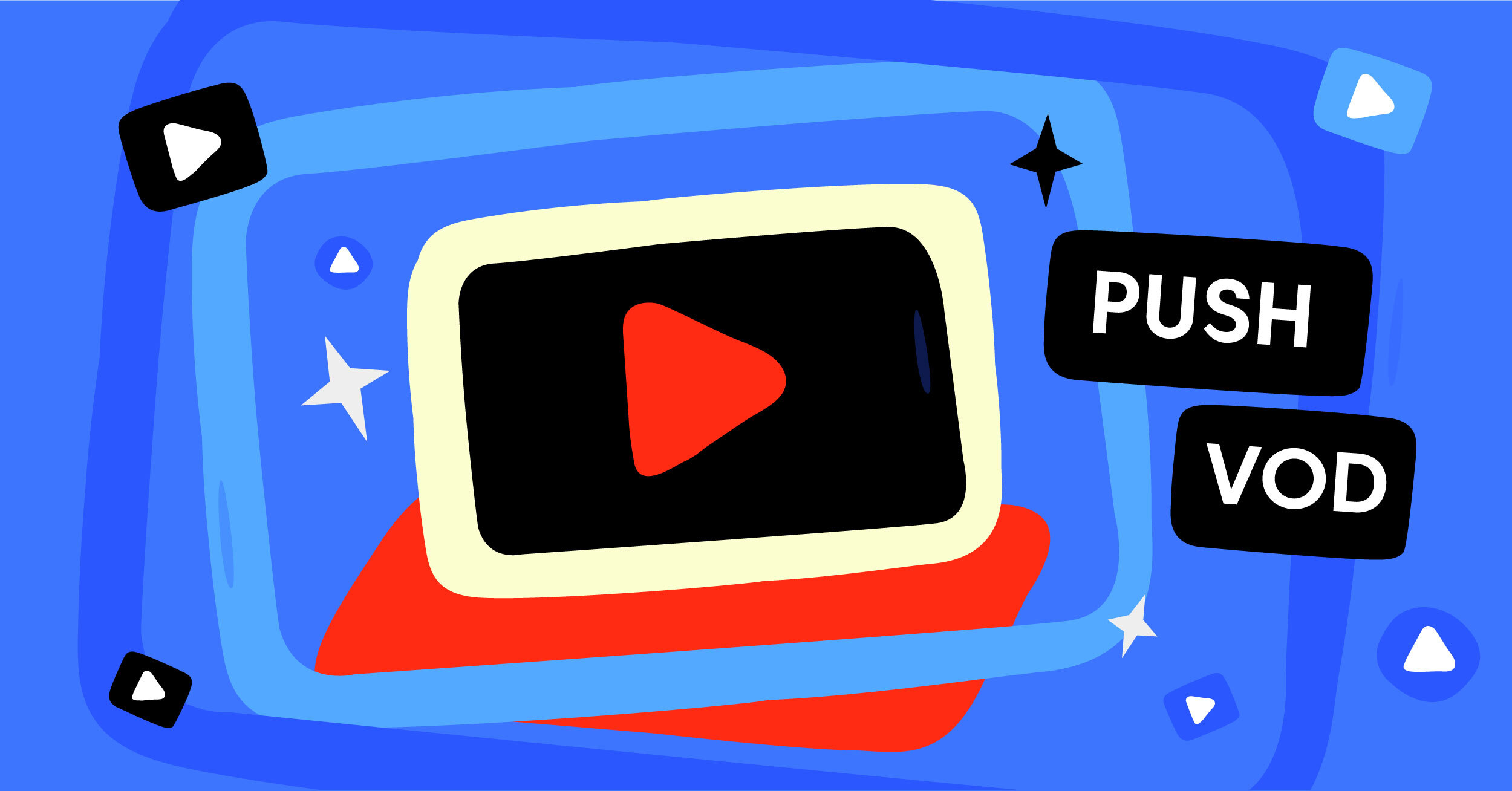Video streaming has changed how we watch and enjoy entertainment today. We can now access our favorite shows and movies anytime, anywhere, through the internet. This shift has created new ways to deliver and consume video content.
SVOD, or Subscription Video on Demand, is a popular streaming business model. It lets viewers access large content libraries by paying a monthly subscription fee. Services like Netflix, Disney+, and Amazon Prime Video are leading examples of SVOD platforms.
The industry continues to grow, with projected revenue reaching US$108.50bn in 2024. This shows how SVOD has become a major force in entertainment.
You might wonder how SVOD works, what makes it different from other streaming models, and why it matters. This guide will explain everything about SVOD streaming. We will explore its benefits, challenges, and impact on the entertainment industry. Let’s dive into the world of subscription-based video streaming.
What is SVOD?
SVOD stands for Subscription Video on Demand, which allows viewers to watch unlimited content for a monthly subscription fee. Netflix, Disney+, and Amazon Prime Video are well-known examples of SVOD platforms.
This media distribution model differs from traditional TV and other streaming options. Users can access the entire video library without ads or viewing restrictions. They can watch their favorite shows and movies on multiple devices anytime, and the subscription fee gives them full access to premium content.
SVOD platforms focus on providing high-quality content to keep subscribers happy. They offer original shows, exclusive movies, and popular series to attract viewers. Most services also provide a free trial period for new users. This helps people test the platform before they commit to a subscription.
The model works well because it gives viewers control over what and when they watch. Users enjoy ad-free entertainment while platforms earn steady revenue through recurring fees.
How Does the SVOD Model Work
The SVOD model uses a simple subscription system that gives users access to video content. Here’s a detailed breakdown of its key components:
Subscription Process
Users start by choosing a pricing model that fits their needs. Most platforms offer different subscription tiers with varying features. They provide payment options and often include a free trial period. After payment, subscribers can access the entire video library.
Content Delivery
The platform streams content directly to users through the internet. Subscribers can watch shows on multiple devices at any time. The service uses advanced technology to ensure smooth playback and high-quality content. Users don’t need to download files, as content streams instantly.
Revenue Generation
SVOD platforms make money through fixed subscription fees from users. They collect recurring fees monthly or yearly from their subscriber base. This steady income helps them invest in new content and improve their services.
Content Management
Platforms maintain and update their content library regularly. They add new shows and remove others based on viewing patterns. Most services create their original content to attract subscribers. They also buy rights to stream popular shows and movies.
Technical Infrastructure of SVOD Model
SVOD platforms rely on several technical components to deliver smooth streaming services. Here’s how each element works together:
Content Delivery Networks (CDN)
A CDN helps deliver video content quickly to viewers across different locations. It stores content copies on multiple servers worldwide. This system reduces buffering and ensures fast loading times for users. The network automatically picks the nearest server to stream content.
Streaming Servers
Streaming servers like Castr manage and distribute video content to viewers. These servers handle multiple user requests at once. Castr offers reliable streaming solutions with features like multi-bitrate streaming. It helps platforms deliver content at various quality levels based on internet speed.
Data Analytics Tools
SVOD platforms use analytics tools to track user behavior and preferences. These tools collect data about viewing patterns and popular content. The insights help services make better content decisions. They also use this data to improve user experience.
Security Measures
Security systems protect content from unauthorized access and piracy. Digital Rights Management (DRM) ensures that only paid subscribers can view content. The platforms also use encryption to secure user data and payment information. These measures build trust with content creators and subscribers.
Quality Control Systems
Quality control ensures viewers get the best possible streaming experience. These systems monitor video quality and streaming performance. They adjust video quality based on network conditions. The platforms also use adaptive bitrate streaming for smooth playback.
This infrastructure works together to provide reliable streaming services. Each component plays a vital role in content delivery. The system handles millions of concurrent streams while maintaining quality. Modern SVOD platforms continue to improve their technical capabilities.
The success of an SVOD service depends on this technical foundation. It must work seamlessly to keep subscribers satisfied. Regular updates and maintenance ensure consistent performance. This infrastructure supports the growing demands of video streaming.
Key Features of SVOD Services
SVOD platforms offer several key features that make them popular among viewers. These features enhance the viewing experience and provide value for subscribers’ access to premium content.
Ad-Free Experience
You can watch your favorite shows without any commercial interruptions. This feature differentiates SVOD from advertising-based video services that rely on ad revenue.
Viewers enjoy uninterrupted entertainment without the usual commercial breaks. The ad-free model creates a more immersive viewing experience similar to traditional cinema. This feature is especially valuable for those who want to focus on their content without disruptions.
Unlimited Access
Subscribers can watch as much content as they want within their subscription period. This unlimited viewing model differs from pay-per-view or transactional video services.
You can binge-watch entire seasons or explore new shows without extra charges. The platform doesn’t limit how often you can watch a specific title. This freedom helps viewers get more value from their subscription fees.
Exclusive Content
SVOD platforms create and offer original shows and movies you can’t find elsewhere. This exclusive content helps services stand out in the competitive streaming market.
These platforms invest heavily in producing high-quality original programming. They also secure exclusive rights to popular shows and movies. This strategy helps them attract and retain subscribers who want access to unique content.
Wide Range of Content
Subscribers can choose from thousands of movies, TV shows, and documentaries. The diverse content library caters to different interests and preferences.
You can find various genres, from action to documentaries, all in one place. This variety helps platforms reach a broader audience and keep viewers engaged. The content mix includes both new releases and classic favorites.
Flexibility
Users can start, pause, or resume watching at their convenience. This flexibility lets viewers control their entertainment schedule.
The on-demand nature of SVOD gives you complete freedom over when to watch. You can create your viewing schedule without following traditional TV programming times.
High-Quality Streaming
SVOD services deliver premium video quality with HD and 4K streaming options. They use advanced technology to ensure smooth playback across different devices.
The platforms optimize streaming based on your internet connection speed. This adaptive streaming helps maintain quality while preventing buffering issues.
Subscription-Based Model
Users pay a fixed monthly fee for full access to the content library. This simple pricing model makes it easy to budget for entertainment.
The subscription model offers better value than paying for individual shows. You can try different content without worrying about additional costs.
Personalized Recommendations
The service suggests content based on your viewing history and preferences. These recommendations help you discover new shows you might enjoy.
Advanced algorithms analyze your watching patterns to make relevant suggestions. This feature saves time and helps you find interesting content quickly.
Multiple Device Support
You can watch content on various devices, from TVs to smartphones. This feature lets you enjoy your favorite shows anywhere.
The service syncs your viewing progress across all your devices. You can switch between devices without losing your place in a show.
Offline Viewing
Many SVOD platforms let you download content for offline watching. This feature is perfect for travel or areas with poor internet connection.
You can save and watch your favorite shows without using data. The downloads usually expire after a set period to protect content rights.
Advantages of SVOD
- Users pay once monthly for unlimited access to all content
- No interruptions from ads while watching shows or movies
- Access to exclusive and original content not available elsewhere
- Viewers can watch content anytime and anywhere with an internet connection
- Multiple users can share one account through family plans
- Free trials let viewers test the service before subscribing
- Regular updates bring fresh content to the platform weekly
- Subscribers access premium video quality with HD and 4K options
Disadvantages of SVOD
- Multiple subscriptions to different platforms can become expensive
- Popular content may leave the platform when licensing deals expire
- Internet connection issues can affect streaming quality and experience
SVOD Services vs Traditional Cable TV: Key Differences
| Feature | SVOD Services (Streaming Video on Demand) | Traditional Cable TV |
| Content Access | On-demand, watch anytime | Scheduled programming only |
| Subscription Model | Monthly fees, often cheaper | Expensive bundles, annual contracts |
| Device Compatibility | Mobile, tablets, smart TVs, computers | Limited to TV and cable boxes |
| Ads | Few or no ads (premium plans) | Frequent ads during shows |
| Channel Selection | Customizable, select specific services | Fixed channel bundles |
| Internet Requirement | Requires high-speed internet | No internet needed |
| Content Updates | Regularly updated with new shows/movies | Seasonal or fixed schedules |
| Portability | Accessible worldwide (if licensed) | Tied to home installation |
| Customization | Personalized recommendations | No customization |
| Setup | Easy setup, no installation needed | Requires professional installation |
Difference Between SVOD, AVOD, and TVOD
SVOD, AVOD, and TVOD are the three main revenue models in video streaming services. Each model offers different ways for platforms to generate revenue and serve their target audience.
SVOD (Subscription Video on Demand): Users pay a monthly fee to access all content on the platform. Netflix and Disney+ use this model to provide ad-free streaming content. Subscribers access unlimited shows and movies without extra charges or interruptions.
AVOD (Advertising-based Video on Demand): This model offers free access to content but includes advertisements during playback. Platforms like Pluto TV make money through ad revenue from commercials. Viewers can watch shows without paying, but they must view ads.
TVOD (Transactional Video on Demand): Users pay for each content they want to watch. This pay-per-view model works well for new movie releases. Amazon Prime Video offers both SVOD and TVOD options to its customers.
Key Differences:
- Payment: SVOD needs monthly fees, AVOD is free, TVOD charges per title
- Ads: SVOD has no ads, AVOD includes ads, and TVOD is ad-free
- Content Access: SVOD offers unlimited access, while AVOD and TVOD limit content differently
- Revenue Source: SVOD uses subscriptions, AVOD relies on advertising, TVOD depends on individual purchases
Many platforms now use hybrid video models to reach a broader audience. They combine different approaches to create flexible viewing options. This strategy helps services maximize their revenue while meeting various user preferences.
Step-by-step Guide for Building an SVOD Platform

1. Define Your Niche and Audience
You need to identify your target audience before launching your own SVOD platform. This step helps you understand what content your viewers want and how to reach them effectively. We recommend researching market gaps and finding unique opportunities that other services haven’t covered yet.
Your platform’s success depends on how well you understand your viewers’ needs and preferences. You should collect data about their viewing habits, content preferences, and payment capabilities. This information will help you create a service that appeals to your target audience. Focusing on a specific niche is better than competing with giants like Netflix or Disney+.
2. Plan Your Content Strategy
Your content strategy determines what videos you will offer your subscribers access to. You need to decide whether to create original content, license existing shows or use a mix of both. This decision affects your budget and your platform’s unique selling point.
We suggest starting with a clear content roadmap that matches your audience’s interests. You should plan how often you’ll add new content and what types of shows or movies you’ll feature. Consider making deals with content creators or studios to ensure a steady flow of streaming content. Your strategy should also include plans for content organization and categorization.
3. Choose a Monetization Model
Your platform needs a clear plan to generate revenue through subscription services. You can choose between revenue models like tiered pricing, single-plan subscriptions, or hybrid video approaches. This decision affects how users pay and access your content.
The right monetization strategy balances viewer satisfaction with profitable operations. You might offer premium video features in higher-priced tiers while keeping basic access affordable. Consider testing different price points with your target audience before launch. Remember that multiple subscriptions can lead to subscription fatigue among viewers.
4. Select a Platform Development Method
You must choose how to build your video platform’s technical infrastructure. This decision involves picking between custom development, ready-made solutions, or modified existing platforms. Your choice affects development time, costs, and platform flexibility.
We recommend evaluating different development options based on your budget and technical needs. You can use existing streaming solutions to save time and money. However, custom development gives you more control over features and user experience. Consider working with experienced developers who understand video services.
5. Build the Core Features
Your platform needs essential features that make it work smoothly for viewers. These include user registration, content management, payment processing, and video playback systems. The core features form the foundation of your streaming service.
Start by implementing basic functions that let users access video content easily. You should focus on creating a reliable streaming system with good video quality. Add features like user profiles, watchlists, and search functions. Ensure your platform works well on different devices and at different internet speeds.
6. Ensure Scalability and Performance
Your SVOD platform needs a strong technical foundation to handle growing user numbers. We recommend building a system that can scale up smoothly as your subscriber base increases. This approach helps maintain quality service while managing costs effectively.
You should invest in reliable servers and content delivery networks for better performance. Your platform must handle peak viewing times without buffering or quality issues. We suggest using cloud services that can adjust resources based on demand. This flexibility helps you serve more viewers without major technical changes.
7. Focus on User Experience
A good user experience keeps subscribers happy and reduces cancellations. Create an interface that makes finding and watching content easy. We recommend testing your platform with real users before the full launch.
Your platform needs clear navigation and fast loading times across all devices. The search function should help viewers find content quickly and accurately. You should add features like watchlists and viewing history to improve convenience. Regular user feedback helps you identify and fix problems that affect viewer satisfaction.
8. Integrate Analytics and Reporting
Analytics tools help you understand how viewers use your platform. You must track important metrics like viewing time, popular content, and subscription patterns. This data helps you make better decisions about content and features.
We suggest setting up detailed reporting systems to monitor platform performance. You should track user behavior, content performance, and technical issues. These insights help you improve your service and keep subscribers happy. Regular data analysis helps you spot trends and adjust your strategy accordingly.
9. Implement Security Measures
Your platform needs strong security to protect content and user data. We recommend using encryption and secure payment systems to build trust. You should also add features to prevent unauthorized sharing of accounts.
Digital rights management helps protect your content from piracy. Your security system should guard against data breaches and cyber-attacks. We suggest regular security audits to find and fix potential vulnerabilities. This protection helps maintain good relationships with content providers and subscribers.
10. Launch and Market Your Platform
A successful launch needs careful planning and effective marketing. You should create buzz before launch through social media and advertising. We recommend offering special deals or free trials to attract early subscribers.
Your marketing strategy should highlight your platform’s unique features and content. You need to reach your target audience through the right channels. Consider partnerships with content creators or other businesses. Clear communication about your service helps set correct expectations for new subscribers.
11. Monitor and Optimize Post-Launch
After launch, you need to watch how your platform performs and make improvements. We suggest collecting user feedback and monitoring key performance indicators. This information helps you fix problems and enhance your service.
Regular updates keep your platform fresh and competitive. You should track subscriber growth and retention rates closely. We recommend testing new features before the full rollout. Your platform needs to evolve based on changing viewer needs and market trends.
SVOD Market Trends and Growth
The SVOD streaming service market shows strong growth with projected revenue of US$108.50bn in 2024. This sector continues to expand as more viewers switch to subscription-based streaming services worldwide. The market expects an 8.27% growth rate from 2024 to 2027.

The United States leads the global SVOD market with an expected revenue of US$43,970.00m in 2024. Popular SVOD platforms like Netflix dominate the U.S. market through extensive content libraries. The average revenue per user is US$76.58, showing strong consumer spending on streaming services.
User numbers tell an impressive growth story for subscription-based services across the globe. We expect the total users to reach 1.6 billion by 2027. The current user penetration rate is 18.3% and will likely grow to 20.7% by 2027. Key growth markets include South Korea, Japan, India, and the United Kingdom.

The market definition helps us understand this growth better. Unlike ad-supported platforms or pay-per-view services, SVOD offers on-demand content through monthly subscriptions. This model gives viewers pay options for unlimited access to content libraries. The service excludes traditional TV subscriptions and video ad systems.
[Data and Image Source: Statista]
Build Your SVOD Platform with Castr
Castr offers powerful tools to help you build your own SVOD streaming service. You can start your video business with our reliable streaming infrastructure and advanced features. Our platform makes it easy to launch your streaming service quickly and efficiently.
We provide a complete solution for subscription-based services with powerful servers and technology. You can deliver high-quality content to your viewers without worrying about technical issues. Our subsecond latency ensures smooth playback and an excellent viewing experience for your audience.
You can choose from flexible pricing options to match your streaming needs. We offer tiered pricing models that grow with your business and viewer base. Our platform supports various monetization methods, including subscription plans and pay-per-view options.
Castr’s platform includes essential features for running a successful SVOD service. You get content management tools, payment processing, and analytics to track performance. We also provide security features to protect your content and ensure that only paying subscribers can access it.
Ready to start your SVOD platform? Try Castr today and experience the power of professional streaming technology. You can sign up for a free trial to test our features and see how we can help your streaming business grow. Contact our team to learn more about building your SVOD service with Castr.








